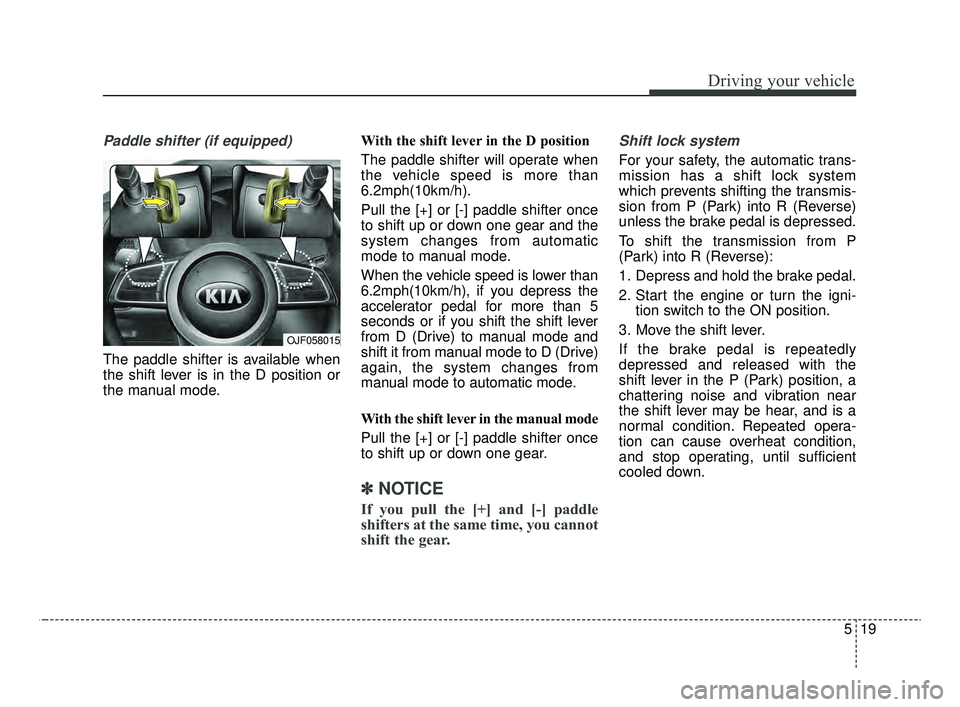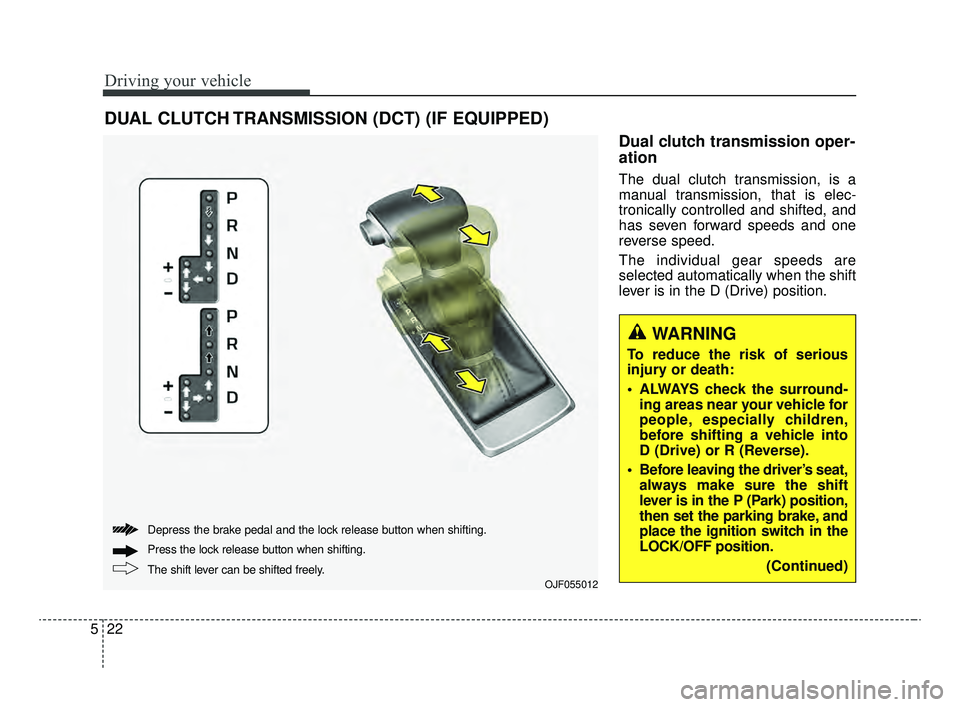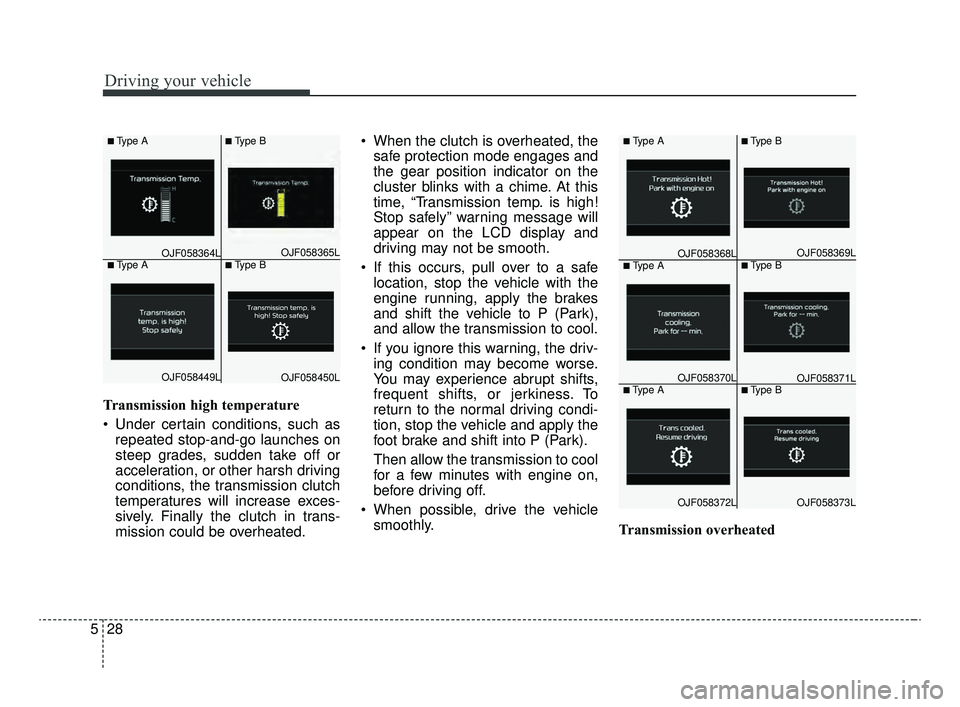transmission KIA OPTIMA 2020 Features and Functions Guide
[x] Cancel search | Manufacturer: KIA, Model Year: 2020, Model line: OPTIMA, Model: KIA OPTIMA 2020Pages: 591, PDF Size: 14.1 MB
Page 275 of 591

519
Driving your vehicle
Paddle shifter (if equipped)
The paddle shifter is available when
the shift lever is in the D position or
the manual mode.With the shift lever in the D position
The paddle shifter will operate when
the vehicle speed is more than
6.2mph(10km/h).
Pull the [+] or [-] paddle shifter once
to shift up or down one gear and the
system changes from automatic
mode to manual mode.
When the vehicle speed is lower than
6.2mph(10km/h), if you depress the
accelerator pedal for more than 5
seconds or if you shift the shift lever
from D (Drive) to manual mode and
shift it from manual mode to D (Drive)
again, the system changes from
manual mode to automatic mode.
With the shift lever in the manual mode
Pull the [+] or [-] paddle shifter once
to shift up or down one gear.
✽ ✽
NOTICE
If you pull the [+] and [-] paddle
shifters at the same time, you cannot
shift the gear.
Shift lock system
For your safety, the automatic trans-
mission has a shift lock system
which prevents shifting the transmis-
sion from P (Park) into R (Reverse)
unless the brake pedal is depressed.
To shift the transmission from P
(Park) into R (Reverse):
1. Depress and hold the brake pedal.
2. Start the engine or turn the igni-
tion switch to the ON position.
3. Move the shift lever.
If the brake pedal is repeatedly
depressed and released with the
shift lever in the P (Park) position, a
chattering noise and vibration near
the shift lever may be hear, and is a
normal condition. Repeated opera-
tion can cause overheat condition,
and stop operating, until sufficient
cooled down.
OJF058015
JFa PE USA 5.QXP 5/17/2019 4:30 PM Page 19
Page 278 of 591

Driving your vehicle
22
5
Dual clutch transmission oper-
ation
The dual clutch transmission, is a
manual transmission, that is elec-
tronically controlled and shifted, and
has seven forward speeds and one
reverse speed.
The individual gear speeds are
selected automatically when the shift
lever is in the D (Drive) position.
DUAL CLUTCH TRANSMISSION (DCT) (IF EQUIPPED)
OJF055012The shift lever can be shifted freely. Press the lock release button when shifting. Depress the brake pedal and the lock release button when shifting.
WARNING
To reduce the risk of serious
injury or death:
ALWAYS check the surround-
ing areas near your vehicle for
people, especially children,
before shifting a vehicle into
D (Drive) or R (Reverse).
Before leaving the driver’s seat, always make sure the shift
lever is in the P (Park) position,
then set the parking brake, and
place the ignition switch in the
LOCK/OFF position.
(Continued)
JFa PE USA 5.QXP 5/15/2019 3:21 PM Page 22
Page 279 of 591

523
Driving your vehicle
The dual clutch transmission canbe thought of as an automatically
shifting manual transmission. It
gives the driving feel of a manual
transmission, yet provides the
ease of a fully automatic transmis-
sion.
When D (Drive) is selected, the transmission will automatically shift
through the gears similar to a con-
ventional automatic transmission.
Unlike a traditional automatic
transmission, the gear shifting can
sometimes be felt and heard as the
actuators engage the clutches and
the gears are selected.
The dual clutch transmission adopts a dry-type dual clutch,
which is different from the torque
converter of the automatic trans-
mission. It shows better accelera-
tion performance and increased
fuel efficiency while driving but ini-
tial launch might be little bit slower
than the automatic transmission.(Continued)
Unexpected and sudden vehi-
cle movement can occur if
these precautions are not fol-
lowed.
Do not use engine braking (rapidly shifting from a high
gear to lower gear) on slip-
pery roads. The vehicle may
slip causing an accident.CAUTION
To avoid damage to your transmission, do not try toaccelerate with the shift leverin R (Reverse) or any forwardgear position with the brakeengaged.
When stopped on a slope, do not hold the vehicle with accel-erator pedal. Engage the serv-ice brake or the parking brake.
When in any gear than P, and on an incline, if you release thebrake pedal for more than 3seconds, the vehicle may rollforward or backwards (unlessvehicle hold is ON).
JFa PE USA 5.QXP 5/15/2019 3:21 PM Page 23
Page 280 of 591

Driving your vehicle
24
5
As a result, gear shifts are some-
times more noticeable than a con-
ventional automatic transmission
and a light vibration during launch-
ing can be felt as the transmission
speed is matched with the engine
speed. This is a normal condition of
the dual clutch transmission.
The dry-type clutch transfers torque more directly and provides a direct-
drive feeling which may feel differ-
ent from a conventional automatic
transmission with a torque convert-
er. This may be more noticeable
when launching the vehicle from a
stop or when traveling at low, stop-
and-go vehicle speeds.
When rapidly accelerating at a low vehicle speed, the engine rpm may
increase depending on the vehicle’s
driving condition.
For smooth launch uphill, press down the accelerator pedal
smoothly depending on the current
conditions. If you release your foot from the
accelerator pedal at low vehicle
speed, you may feel strong engine
braking, which is similar to manual
transmission.
When driving downhill, you may use Sports Mode or press the pad-
dle shifters (if equipped) to down-
shift to a lower gear in order to con-
trol your speed without using the
brake pedal excessively.
When you turn the engine on and off, you may hear clicking sounds
as the system goes through a self
test. This is a normal sound for the
Dual Clutch Transmission.
During the first 1,500 km (1,000 miles), you may feel that the vehi-
cle may not be smooth when accel-
erating at low speed. During this
break-in period, the shift quality
and performance of your new vehi-
cle is continuously optimized.✽ ✽ NOTICE
• Always come to a complete stop
before shifting into D (Drive) or R
(Reverse).
• Do not put the shift lever in N (Neutral) while driving.
✽ ✽ NOTICE
If your transmission should fail,
your gear shift lever may not move
and the position indicator (D,R,N,
etc.) will blink on the cluster. If this
occurs, have the system checked by
an authorized Kia dealership.
JFa PE USA 5.QXP 5/15/2019 3:21 PM Page 24
Page 281 of 591

525
Driving your vehicle
LCD display for transmission
temperature and warning mes-
sage
Transmission temperature Gauge
Select trip computer mode on theLCD display and move to the trans-
mission temperature screen to see
the temperature of the dual clutch
transmission.
Try to drive so that the temperature gauge do not show high/overheat.
When the transmission is over-
heated, the warning message will
display on the LCD. Follow the dis-
played message.
The transmission temperature is displayed in three colors (white,
orange and red) as it increases. (if
equipped with the color type clus-
ter) if equipped with the mono type
cluster. temperature gauge is dis-
played in one color (white).
Orange temperature gauge is dis- played right before the warning
message appears on the LCD dis-
play. (if equipped)
OJF058364L
OJF058368L
CAUTION
Increase (high temperature) ofthe transmission temperaturegauge usually appears on anincline when the vehicle isstopped for a long time usingaccelerator pedal, withoutdepressing the brake pedal.
JFa PE USA 5.QXP 5/15/2019 3:22 PM Page 25
Page 283 of 591

527
Driving your vehicle
High/Overheat (from marking 15 to
16)
This zone shows that the dualclutch temperature of the DCT has
entered the high/overheat zone.
The DCT warning alarm sounds,
warning message is displayed on
the cluster and the temperature
gauge disappears from the cluster.
Follow the displayed warning
message.
To check the temperature status of the dual clutch when overheated,
move to the temperature gauge
screen by selecting the trip com-
puter mode. Then, you can check
the temperature status of the dual
clutch.
DCT warning messages
This warning message is displayed
when the vehicle is driven slowly on
a grade and the vehicle detects that
the brake pedal is not applied. Steep grade
Driving up hills or on steep grades:
To hold the vehicle on an incline
use the foot brake or the parking
brake.
When in stop-and-go traffic on an incline, keep some distance ahead
before moving the vehicle forward.
Then hold the vehicle on the incline
with the foot brake.
If the vehicle is held on a hill by applying the accelerator pedal or
by creeping forward with the brake
pedal disengaged, the clutch and
transmission may overheat which
can result in damage. At this time,
a warning message will appear on
the LCD display.
If the LCD warning is active, the foot brake must be applied.
Ignoring the warnings can lead to damage to the transmission.
OJF058362L
■Type A
■Type B
OJF058363L
OJFA058365
JFa PE USA 5.QXP 5/15/2019 3:22 PM Page 27
Page 284 of 591

Driving your vehicle
28
5
Transmission high temperature
Under certain conditions, such as
repeated stop-and-go launches on
steep grades, sudden take off or
acceleration, or other harsh driving
conditions, the transmission clutch
temperatures will increase exces-
sively. Finally the clutch in trans-
mission could be overheated. When the clutch is overheated, the
safe protection mode engages and
the gear position indicator on the
cluster blinks with a chime. At this
time, “Transmission temp. is high!
Stop safely” warning message will
appear on the LCD display and
driving may not be smooth.
If this occurs, pull over to a safe location, stop the vehicle with the
engine running, apply the brakes
and shift the vehicle to P (Park),
and allow the transmission to cool.
If you ignore this warning, the driv- ing condition may become worse.
You may experience abrupt shifts,
frequent shifts, or jerkiness. To
return to the normal driving condi-
tion, stop the vehicle and apply the
foot brake and shift into P (Park).
Then allow the transmission to cool
for a few minutes with engine on,
before driving off.
When possible, drive the vehicle smoothly. Transmission overheated
■Type A■Type B
OJF058369L■Type A■Type B
■Type A■Type B
OJF058372LOJF058373L
OJF058368L
OJF058370LOJF058371L
■Type A■Type B
OJF058365L■Type A■Type B
OJF058449LOJF058450L
OJF058364L
JFa PE USA 5.QXP 5/15/2019 3:22 PM Page 28
Page 285 of 591

529
Driving your vehicle
If the vehicle continues to be driv-en and the clutch temperatures
reach the maximum temperature
limit, the “Transmission Hot! Park
with engine on” warning will be dis-
played. When this occurs the clutch
is disabled until the clutch cools to
normal temperatures.
The warning will display a time to wait for the transmission to cool.
If this occurs, pull over to a safe location, stop the vehicle with the
engine running, apply the brakes
and shift the vehicle to P (Park),
and allow the transmission to cool.
When the message “Trans cooled. Resume driving.” appears you can
continue to drive your vehicle.
When possible, drive the vehicle smoothly.
If any of the warning messages in
the LCD display continue to blink, for
your safety, take your vehicle to an
authorized Kia dealer and have the
system checked.Transmission ranges
The indicator in the instrument clus-
ter displays the shift lever position
when the ignition switch is in the ON
position.
P (Park)
Always come to a complete stop
before shifting into P (Park).
To shift from P (Park), you must
depress the brake pedal and make
sure your foot is off the accelerator
pedal.
If you have done all of the above
and still cannot shift the lever out
of P (Park), see “Shift-Lock
Release” in this chapter.
The shift lever must be in P (Park)
before turning the engine off.WARNING
Shifting into P (Park) while the vehicle is in motion may
cause you to lose control of
the vehicle.
After the vehicle has stopped, always make sure the shift
lever is in P (Park), apply the
parking brake, and turn the
engine off.
When parking on an incline, block the wheels to prevent
the vehicle from rolling down.
Do not use the P (Park) position in place of the parking brake.
JFa PE USA 5.QXP 5/15/2019 3:22 PM Page 29
Page 286 of 591

Driving your vehicle
30
5
R (Reverse)
Use this position to drive the vehicle
backward.
N (Neutral)
The wheels and transmission are not
engaged.
Use N (Neutral) if you need to restart
a stalled engine, or if it is necessary
to stop with the engine ON. Shift into
P (Park) if you need to leave your
vehicle for any reason.
Always depress the brake pedal
when you are shifting from N
(Neutral) to another gear. - Parking in N (Neutral) gear
Follow the steps below when parking
and you want the vehicle to move
when pushed.
1.After parking your vehicle, step on
the brake pedal and move the shift
lever to [P] with the ignition button in
[ON] or while the engine is running.
2.If the parking brake is applied unlock the parking brake.
- For EPB (Electronic ParkingBrake) equipped vehicles, push
the brake pedal with the ignition
button in [ON] or while the engine
is running to disengage the park-
ing brake. If [AUTO HOLD] func-
tion is used while driving (If
[AUTO HOLD] indicator is on in
the cluster), press [AUTO HOLD]
switch and [AUTO HOLD] func-
tion swill be turned off.
3.While pressing the brake pedal, turn the ignition button [OFF].
- For smart key equipped vehicles,the ignition switch can be moved
to [OFF] only when the shift lever
is in [P].
WARNING
Do not shift into gear unless
your foot is firmly on the brake
pedal. Shifting into gear when
the engine is running at high
speed can cause the vehicle to
move very rapidly. You may lose
control of the vehicle and cause
accidents.
WARNING
Do not drive with the shift lever
in N (Neutral). The engine brake
will not work which could
increase the risk of an accident.
CAUTION
Always come to a complete stopbefore shifting into or out of R(Reverse); you may damage thetransmission if you shift into R(Reverse) while the vehicle is inmotion.
JFa PE USA 5.QXP 5/15/2019 3:22 PM Page 30
Page 287 of 591
 while pressing the brake
pedal and pushing [SHIFT LOCK
RELEASE] button or inserting a
tool (e.g. flathead screw-driver) into
the KIA OPTIMA 2020 Features and Functions Guide 531
Driving your vehicle
4.Change the gear shift lever to [N](Neutral) while pressing the brake
pedal and pushing [SHIFT LOCK
RELEASE] button or inserting a
tool (e.g. flathead screw-driver) into
the](/img/2/55014/w960_55014-286.png)
531
Driving your vehicle
4.Change the gear shift lever to [N](Neutral) while pressing the brake
pedal and pushing [SHIFT LOCK
RELEASE] button or inserting a
tool (e.g. flathead screw-driver) into
the [SHIFT LOCK RELEASE]
access hole at the same time.
Then, the vehicle will move when
external force is applied.✽ ✽ NOTICE
• After the ignition switch has been
turned off, the electronic parking
brake cannot be disengaged.
• For EPB (Electronic Parking Brake) equipped vehicles with
[AUTO HOLD] function used
while driving, if the ignition but-
ton has been turned [OFF], the
electronic parking brake will be
engaged automatically. Therefore,
[AUTO HOLD] function should
be turned off before the ignition
button is turned off.
D (Drive)
This is the normal driving position.
The transmission will automatically
shift through a seven-gear
sequence, providing the best fuel
economy and power.
For extra power when passing anoth-
er vehicle or driving uphill depress
the accelerator pedal further until
you feel the transmission downshift
to a lower gear.
WARNING
With the exception of parking
in neutral gear so that you can
push the vehicle, always park
the vehicle in [P] (Park) for
safety and engage the parking
brake.
Before parking in [N] (Neutral) gear, first make sure the park-
ing ground is level and flat. Do
not park in [N] gear on any
slopes or gradients.
If parked and left in [N], the
vehicle may move and cause
serious damage and injury.
JFa PE USA 5.QXP 5/15/2019 3:22 PM Page 31